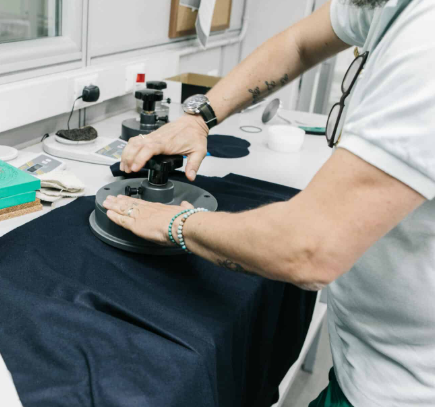Safer by Design: How Fabric Testing Has Evolved Over the Last Decade
BY BRYAN JINNETT
When you wear a uniform every day, you should be able to trust that it is made to perform and made to protect you. Over the past decade, advances in textile science have reshaped how companies like JWE design and evaluate garments, making today’s fabrics cleaner, safer, and more responsibly produced than ever before.
At JWE, safety and performance go hand in hand. The same processes that ensure your uniform holds color, resists wear, and looks professional also ensure that the materials we use meet the world’s most advanced global standards.
The New Era of Textile Testing
Ten years ago, fabric testing focused mainly on durability such as how well a garment resisted shrinking, fading, or tearing. Those remain important measures, but today’s testing goes much deeper. Modern laboratories can now detect trace levels of hundreds of different substances that older methods could not identify.
This change has been driven by global standards including OEKO TEX, AFIRM, and ZDHC, which continue to evolve based on the latest research and regulations. The OEKO TEX STANDARD 100 (2025) introduced one of the most significant updates in recent years, lowering allowable limits for substances such as BPA and PFAS, improving traceability in leather, and refining certification rules for organic cotton.
These updates strengthen what the OEKO TEX label represents. When a material carries this certification, it has been reviewed against some of the strictest and most up to date safety criteria in the world.
Understanding PFAS and What Has Changed
You may have seen the term PFAS in the news. PFAS stands for per and polyfluoroalkyl substances, a large family of materials that have been used for decades to help fabrics repel water, oil, and stains. PFAS helped pioneer the durable water repellents that kept uniforms cleaner for longer, and they are related to familiar products such as Teflon.
It is important to understand that PFAS are not the same as wrinkle resistant or easy-care finishes. Wrinkle free fabrics use a completely different chemistry that helps cotton and blends stay smooth after washing, while PFAS finishes are designed specifically for liquid resistance.
In recent years, new test methods such as EN 17681 1:2025 have allowed laboratories to detect even trace amounts of PFAS that older methods missed. At the same time, textile mills have introduced modern, low fluorine or non-fluorinated finishes that maintain performance without relying on legacy chemistry.
At JWE, we work with mills that have transitioned to these updated, compliant finishes. When testing is requested by our clients, we provide independent laboratory results using the latest standards for full transparency and assurance.
Stronger Standards and Safer Materials
The past decade has brought stronger global controls to every part of textile production.
OEKO TEX STANDARD 100 (2025) lowered limits for BPA, PFAS, and heavy metals, introduced more transparency for leather sourcing, and required verified certification for organic cotton.
The AFIRM Group 2024 Restricted Substances List created a unified framework for chemical safety that leading brands and suppliers now follow.
The ZDHC MRSL (Manufacturing Restricted Substances List) promotes upstream control, helping ensure chemical safety begins long before fabric production.
Together, these programs have raised accountability across the industry and given manufacturers a reliable structure to evaluate materials and suppliers.
How JWE Puts It Into Practice
Our commitment to quality begins with long-standing relationships with mills and suppliers known for their consistency and compliance. We partner with facilities that align with internationally recognized programs such as OEKO TEX, ZDHC, and AFIRM, which promote responsible chemical management and safer textile manufacturing practices.
Because our programs draw from these trusted supply chains, every client benefits from materials that meet the latest global standards. When a client requests laboratory verification, JWE facilitates testing through accredited independent labs and provides all related documentation. These reports confirm that the fabrics in use meet the same safety criteria applied across the broader industry.
This approach provides confidence that every JWE product reflects the same commitment to quality, safety, and continuous improvement.
What Means for You
The progress in textile testing over the past ten years has raised the bar for safety and confidence in every garment. Today’s uniforms are softer, longer lasting, and certified under global systems that make chemical safety measurable and traceable.
At JWE, our role is to stay ahead of these standards and ensure our partners and every wearer benefit from materials made to perform responsibly. It is part of what we call Thinking Beyond Uniformity®, our promise to deliver comfort, quality, and confidence you can feel every day.

